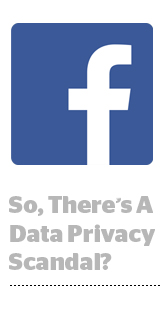
Facebook might be weathering more headwinds than you can shake a stick at right now, but that didn’t stop it from posting gangbuster earnings on Wednesday.
Revenue for the quarter clocked in at $11.97 billion, up 49% year over year – beating the Street’s estimate of $11.41 billion. Click here to read the release.
Proof that advertisers aren’t leaving the platform: increased ad prices.
Whereas on Twitter, where supply still exceeds demand, ad load is maxing out on Facebook. In Q1, the average price per ad on Facebook shot up 49% at the same time the number of ad impressions served increased by 8%, mainly driven by feed ads and ads on Instagram.
In other words, advertisers were willing to pay higher prices for access to Facebook inventory. If advertisers were defecting due to concerns over data privacy or for any other reason, prices would have declined.
And how does Facebook make the lion’s share of its money? Senator, we run ads.
The vast majority of Facebook’s Q1 revenue – $11.8 billion – was thanks to advertising, a 50% uptick from this time last year. Mobile represented 90% of ad revenue for the quarter, up from 85% in Q1 2017.
But even if some advertisers start to flee as part of the fallout from Cambridge Analytica, the impact wouldn’t have registered this quarter. The data scandal broke in March, nearly three months into the quarter.
Facebook claims to have learned its lesson from Cambridge Analytica and other recent headlines from hell, including those related to foreign manipulation and Facebook’s role in the Myanmar humanitarian crisis.
“We’re going through every part of our relationship with people and making sure we’re taking a broad enough view of our responsibility – not just to build tools, but to make sure our tools are used for good,” Mark Zuckerberg told investors.
But in order to make sure its services are used for good, Facebook needs to ensure that its services are used, full stop.
Daily active users in the US and Canada actually declined by 700,000 last quarter. North America is Facebook’s most lucrative market, and another decline in use could be a canary in the coal mine for a more macro problem than Cambridge Analytica – the fact that younger people prefer other social networks to Facebook.
But DAUs bounced back in North America to 185 million in Q1. Overall daily active users for March clocked in at 1.45 billion, a 13% YoY increase. Monthly active users totaled 2.2 billion.
At the same time, CFO David Wehner warned investors that European MAUs and DAUs could remain flat or trend downward sequentially in Q2 as a result of the General Data Protection Regulation, set to take effect in the EU on May 25.
And “while we don’t anticipate these changes will significantly impact advertising revenue, there is certainly the potential for some impact,” Wehner cautioned. “We’re monitoring this closely.”
Facebook is in the process of rolling out more robust data management controls for its European users, although it’s also planning to extend those same controls to all users, regardless of where they’re located.
Although Facebook doesn’t anticipate users restricting their data sharing en masse, if they did, it could negatively affect the way Facebook functions, said COO Sheryl Sandberg.
“There are lots of ways we use data to make the product better,” she said. “But we don’t have full visibility into what changes would be like over the long term.”
In that case, what about some form of monetization other than advertising?
Facebook management has zero interest in moving away from an ad-based model as its core revenue driver.
“We think that ads is a great business model that’s aligned with our mission,” Zuckerberg said. “We want to build services that can connect people all around the world … we want to offer our services for free.”
But building services for more than 2 billion people comes attendant with a responsibility to effectively police the platform. Facebook has been repeatedly criticized for its failure to tamp down hate speech in particular.
The criticism is a fair one, Zuckerberg said. Facebook is working on training its machine learning models, but the process is ongoing. Today, AI lends itself to identifying some types of content more easily than others.
“We’re much better able to enforce our nudity policies, for example, than we are hate speech, and the reason for that is it’s much easier to build an AI system that can detect a nipple than what is linguistically hate speech,” Zuckerberg said. “This is something we will make progress on and get better over time. These are not unsolvable problems.”
This post was syndicated from Ad Exchanger.

More Stories
Garnier and MADE THIS launch OOH across NZ & Australia
Lululemon Taps Google’s Brandon Viney as North America Brand Creative Director
Clemenger, TBWA win big at ORCAs